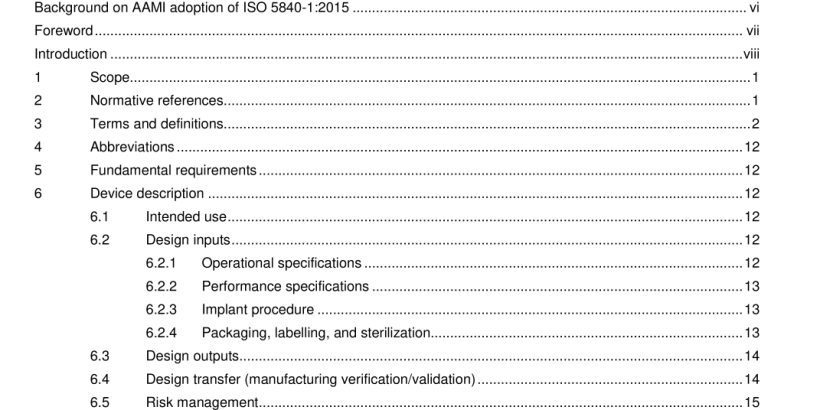ANSI AAMI ISO 5840-1-2015 pdf download
ANSI AAMI ISO 5840-1-2015 pdf download.Cardiovascular implants—Cardiac valve prostheses
The rationale for basing this part of ISO 5840 on risk management is that the traditional requirements-based model cannot keep up with the speed of technological innovation. With the requirements-based model, manufacturers have to spend their time looking for ways to comply with the requirements of the standard rather than on developing new technologies that could lead to inherently safer products. The risk-based model challenges the manufacturer to continually evaluate known and theoretical risks of the device to develop the most appropriate methods for reducing the risks of the device and to implement the appropriate test and analysis methods to demonstrate that the risks have been reduced. This part of ISO 5840 combines a requirement for implementing the risk-based model with best practice methods for verification testing appropriate to heart valve system evaluation. The intent of the risk assessment is to identify the hazards along with the corresponding failure modes and causes in order to identify the requisite testing and analysis necessary to evaluate the risk associated with each specific hazard. The risk management process provides the opportunity for the manufacturer to evaluate the best practice methods included within this part of ISO 5840. The manufacturer may choose to follow the best practice method as defined within this part of ISO 5840 or may deviate from the method and provide a scientific justification for doing so. The risk management file required by ISO 1 4971 should document these decisions with rationale. The risk-based model requires a collaborative environment between the device developer (the manufacturer) and the body responsible for verifying compliance with the applicable regulation regarding safety and performance of the device. The manufacturer should strive for continuous improvement in device design, as well as test methodologies that can ensure safety and performance of a device with less reliance on years of patient experience for evidence of effectiveness.
The overall objective of preclinical in vivo evaluation is to test the safety and function of the heart valve system in a biological environment with the closest practically feasible similarity to human conditions. The preclinical in vivo evaluation is the final investigational step prior to human implantation. Therefore, it should provide the regulatory body with an appropriate level of assurance that the heart valve system will perform safely. No single uniformly acceptable animal model has been established. Therefore, the animal model(s) selected should be properly justified in order to ensure the highest degree of human compatible conditions for the heart valve system pertinent to the issues being investigated. Since chronic studies are conducted to elucidate heart valve substitute hemodynamic performance, biological responses, structural integrity, and delivery system and valve-related pathology in a specific anatomical position, it is preferable to undertake this longer-term testing of the valves in anatomical positions for which it is intended. The concurrent implantation of reference heart valve substitutes enhances the comparative assessment by providing a bridge to known clinical performance. In addition, such an approach facilitates the distinction between the complications related to the reference heart valve substitute versus those of the test heart valve system.
Verification and validation testing includes materials testing, preclinical bench testing, preclinical in vivo evaluation, and clinical investigations. Although clinical investigations are usually considered to be part of design validation, some of the requirements established under design input might be verifiable only under clinical conditions. The tests specified herein do not purport to comprise a complete test program. A comprehensive test program for the heart valve system should be defined as part of the risk assessment activities. Where the manufacturer’s risk assessment concludes that the safety and performance will be better demonstrated by other tests or by modifying the test methods included in this standard, the manufacturer should include in the risk assessment a justification of the equivalence or superiority of the alternative test or test method.
